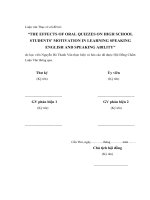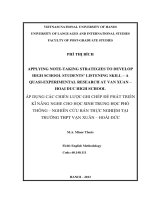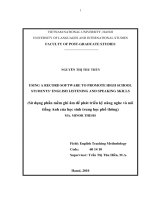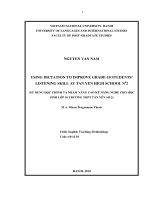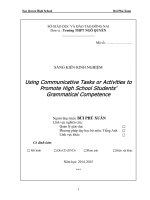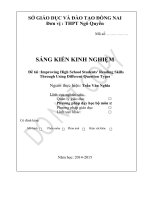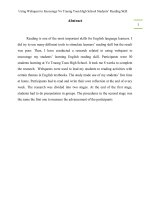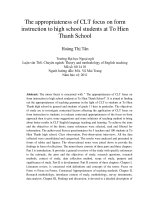SKKN Using context to improve high school students’ vocabulary
Bạn đang xem bản rút gọn của tài liệu. Xem và tải ngay bản đầy đủ của tài liệu tại đây (97.64 KB, 10 trang )
SỞ GIÁO DỤC VÀ ĐÀO TẠO ĐỒNG NAI
Đơn vị : THPT Ngô Quyền
Mã số: ………………
SÁNG KIẾN KINH NGHIỆM
Đề tài :Using context to improve high school students’ vocabulary
Người thực hiện: Trần Văn Nghĩa
Lĩnh vực nghiên cứu:
Quản lý giáo dục
Phương pháp dạy học bộ môn
Phương pháp giáo dục
Lĩnh vực khác:
Có đính kèm:
Mô hình
Phần mềm
Phim ảnh
Hiện vật khác
Năm học: 2016-2017
SƠ LƯỢC LÝ LỊCH KHOA HỌC
I. THÔNG TIN CHUNG VỀ CÁ NHÂN
1. Họ và tên: Trần Văn Nghĩa
2. Ngày tháng năm sinh : 20-11-1963
3. Nam/Nữ: Nam
4. Địa chỉ: B 28-Khu Phố 6- phường Tam Hiệp- Biên hòa
5. Điện thoại: 0913130131 Cơ quan: 0613829029
Nhà riêng:
6. Fax E-mail:
7. Chức vụ: Tổ trưởng Tổ Tiếng Anh
8. Đơn vị công tác: THPT Ngô Quyền
II. TRÌNH ĐỘ ĐÀO TẠO
Học vị (hoặc trình độ chuyên môn, nghiệp vụ) cao nhất: Thạc sĩ
-
Năm nhận bằng: 2001
-
Chuyên ngành đào tạo: Giảng dạy tiếng Anh
III. KINH NGHIỆM KHOA HỌC:
- Lĩnh vực chuyên môn có kinh nghiệm:
-
Số năm có kinh nghiệm: 26 năm
- Các sáng kiến kinh nghiệm đã có trong 5 năm gần đây:
1. Making speaking tasks more effective and easier for high school students
2. How to increase high school students’ oral communication .
3. Improving High School Students’ Written Competence Through teaching
Grammar in Context
4. Improving High School Students’ Speaking Skill Through Role- play
5. Teaching vocabulary through collocations
Research title: Using context to improve high school students’ vocabulary
OUTLINE OF CONTENTS
No
Contents
Page
1
Introduction
1
2
Rationale
2
3
Aims of the study
2- 3
4
Literature review
3-4
5
Ways to make effective use of context to get
meaning
4
6
Anticipated outcomes
5-6
7
Significance of the proposed study
6
8
Conclusion
6
9
References
7
Introduction
We all are aware of the importance of English to international communication nowadays. In fact,
English is one of the essential tools for students, teachers, businessmen, doctors or technicians in
Vietnam and throughout the world. English is used
to communicate in different situations or
environments. By using English, people can express their ideas, exchange their emotions and collect
information about the world. However, linguistic communication, such as sounds, words or sentences
is not enough. People often use combinations of these language units to express a whole idea in verbal
communication. Text ( written text and spoken text), as a linguistic term, is used to refer to the abovementioned combinations. In theory, a text can express the whole idea of the communicator. In
Discourse Analysis, Brown and Yule (1983) define text as ―the verbal record of a communicative
act. They also say that “text” is produced and interpreted between two people in a certain contextual
situation, because people use language to communicate with others. According to the traditional view
on context, context can be divided into co-text, situational context and cultural context, about which
many linguists have done a lot of research projects on the relations between text and context. In the
linguistic communication, context determines text and text reflects context in the same way. People
have to know how to say and what to say in order to achieve effective communication. People also
have to understand why others say what they say and how they say it in a specific situation according
to different aspects in the context. Different people and other factors will have an impact on the
production and interpretation of the text.
At high schools, we often assist our students with developing the four English skills through spoken
and written texts. One more important aspect of real-life communication we must take into
consideration is lexical knowledge . However, how to improve students’ lexical knowledge in an
effective way is a concern for many English teachers; and many research findings prove that
vocabulary is of great importance for the process of English learning and teaching because students
cannot promote the four language skills without enough vocabulary. In real communication, the
greater number of words and phrases our students have, the better they can convey meaning, interpret
ideas from others for transaction, interaction and information. Besides, vocabulary plays a vital part in
developing reading comprehension and speaking competence. The more words, phrases and lexical
bundles students acquire, the better they are able to understand written and spoken texts. In this study,
we would like to emphasize that teaching vocabulary in context can help students get message across.
By using this method, I think we can encourage the students to meaningfully acquire vocabulary
without translation or rote memorization.
Rationale
Most Vietnamese teachers claim that vocabulary is a difficult area to deal with. Teaching English
vocabulary effectively is a hard job for all teachers from elementary schools to secondary schools or
high schools. Many famous linguists and teachers say that context plays a very important role in
learning and acquiring vocabulary. Without context, isolated words cannot convey meaning in spoken
and written communication. Teaching vocabulary without context fails to help students communicate
meaning or get message across. In reality of teaching, we have recognized that vocabulary is central to
English learning and is of great significance to English students. Words and phrases can facilitate the
four English skills: listening, speaking, reading and writing because words label objects, actions,
ideas. Without words, our intended meaning would not be conveyed. Therefore, the main role of
vocabulary in second and foreign language learning must be taken into account by all teachers and
researchers.
In recent years, a number of approaches, techniques, exercises and tasks have been introduced into
the field in order to teach vocabulary in an efficient way (Hatch & Brown, 1995). They suggest that
teaching vocabulary should not only consist of teaching specific words but also aim at providing
students with strategies necessary to enhance their vocabulary competence. Moreover, the Vietnamese
Ministry of Education and Training requires all teachers of English to focus on students’
communicative competence. The Ministry also asks teachers to assess students’ communicative
competence with all the four language skills and vocabulary in use so that they can meet the needs of
international communication. One solution to the improvement of students’ English vocabulary in
the Vietnamese high school system must be teaching and learning vocabulary in context.
Aims of the proposed study
As an attempt to enrich students’ vocabulary, I will give careful consideration to the ways we teach
and the ways our students learn or acquire vocabulary. It is my hope that I can make improvements in
the teaching and learning of English , particularly teaching and learning vocabulary at Ngo Quyen
High School. The purpose of this study to explore the impact of using context on the development of
students’ vocabulary enrichment. Besides, the study aims to identify students’ problems, their learning
habits with the belief that context does help them understand the meaning of unfamiliar words and
phrases. As a result, context will be included in all lessons for vocabulary practising and the four
English skills. The proposed study consists of an introduction, a review of current literature related to
the definition of context and text, their benefits. The last parts of the research paper are sections
which have an discussion on the significance of the study, anticipated outcomes and minor problems
with a short conclusion and some expectations of the research paper writer.
Literature Review
-The importance of context to the learning of vocabulary:
Teaching vocabulary in context is particularly important. This method of teaching allows students to
comprehend the use of words in authentic context and understand the relationship between forms and
meaning( Nunan 1998, 105). Teaching vocabulary in context also encourages students make use of
words and phrases they have just learnt to negotiate meaning. By using this method of teaching, we are
able to help students focus on real communication for meaning.
In explaining the way to enrich students’ vocabulary, (Nation, 2001) mentions that vocabulary learning
strategies are one important part of language learning strategies which in turn are part of general
learning strategies. He also says that language learning strategies encourage greater overall selfdirection for learners. Self-directed learners are independent learners who are capable of taking
responsibility for their own learning and gradually gaining confidence, involvement and proficiency
(Oxford, 1990).
Context and text:
In defining text and context, Harmer (2004) states that building the writing or speaking habits (with
activities) is of great importance but without experiencing examples of various text types to see how
they are constructed, students are unlikely to become effective writers or speakers. Richards(1992)
points out that a text is a piece of spoken or written language and a text may be considered from the
point of view of its structure or its function, such as, warning, instructing, carrying out a transaction.
He also emphasizes that a full understanding of a text is often impossible without reference to the
context in which it occurs.
In my own definition, the teaching of text type is the process of familiarizing students with a great
variety of generic conventions and linguistic properties. This provides students with knowledge of
the social context within which texts are situated as well as their social functions. As the teaching of
texts should be based on good scaffolding and explicit teaching, students benefit from the large
exposure to a variety of text types. Therefore, students have a sense of flexibility when they are
asked to construct their own written and spoken work. In genre-based teaching approach, the
introduction of text type comprises of the two phases namely building the field and modeling the text
(Derewianka, 1990). Before learners are ready to produce their own written or spoken work, it has
always been better for learners to be fully exposed to text construction and language mechanics used
to express certain purposes (Paltridge, 1996).
In the definition of context, Richards and Platt(1992) states that context is the word which occurs
before or after a particular word, a phrase or even a longer utterance or a text. They also say that the
context often helps in understanding the particular meaning of the word, phrase and text.
Ways to make effective use of context to get meaning:
1.The application of vocabulary:
The ultimate goal in teaching unfarmiliar words and phrases is the application of the words the
students have already learnt. Teachers should supply students with opportunities to make use of new
vocabulary at sentence and text levels (cloze passages), while the teacher’s job is to make sure that
students are using the word correctly and commucatively in context.
2. Synonym/ antonym context clue ( a word or phrase that helps us guess another word/phrase):
(Macmillan English Dictionary- page 259)
It is necessary for teachers to encourage students to recognize context clues in order to comprehend
the meaning of words. A synonym should be used to help students understand the meaning of an
unfamiliar word, as it means the same as or nearly the same as the word that is unfamiliar to the
students.
E.g: ‘My elder sister was highly ambitious. It was her strong desire and determination that made
her become the expert in her accounting’.
E.g: My brother still behaves like a child. I wish he’d grow up.( behave like a child # grow up)
E.g: The trouble with Frank is that he never turns up in time for a meeting. He always arrives late.
( turn up = arrive)
( English 12- pages 161,187)
3. Context clue: Definition or restatement
- In teaching reading comprehension, teachers should provide students with strategies to comprehend
the meaning of unfamiliar words. In many cases, the meaning of the word is in the sentence itself,
usually following the word students want to understand. We should consider the following examples:
E.g: Some of the plays were tragedies, but most were comedies. There were also many satires. Satires
are plays that make fun of someone or something in order to highlight a problem.( Satires = plays
that make fun of sb/sth )
E.g: Nam's duplicity – dishonesty – caused him to steal his colleagues' pensions by sending their
money to an offshore account.( duplicity= dishonesty)
-Teachers should also give a sentence which contains an unfamiliar word and is followed by another
sentence saying the same thing in a much simpler way. Students can understand the unfamiliar
word/phrase without looking it up in a dictionary.
E.g: Her uncle was very dexterous and became one of the most fantastic sculptors. He was able to
use his hand skilfully. He was so good with his hands that every piece he carved was wonderful.
( dexterous = able to use his hand skilfully).
(Macmillan English Dictionary- page 881)
4. Visual context clue:
When we use visual context clue, we rely on pictures, or other types of image, along with some kinds
of related texts to help students to understand the meaning of unfamiliar words. For example, a picture
of a furious man and its caption (words printed on a picture) will help students understand the word
“furiously” in the sentence:
“The manager of the company reacted furiously to the television
reporter’s questions”. Therefore, we do not need to have students translate the word “furiously” into
our native language.
Anticipated outcomes
When we teach reading comprehension, especially helping our students to deal with standardized tests
or passages, we need to help students know some strategies to get message across. I am in the belief
that understanding different types of context clues can help students get the meaning of difficult
words. Context clues are expected to be helpful when students are working to determine the main
idea of a passage. Students are also expected to use this strategy to comprehend the writer’s implied
meaning and to make inferences when they cope with difficult and long reading passages like TOEFL
readings.
When writing this proposed research project, I am also in the hope that I can receive both the teachers
and students’ positive attitude toward the new teaching method. I also anticipate some improvements
in the students’ vocabulary acquisition. If successful, I can actually generalize the implement of
teaching vocabulary in context on a larger number of students in other schools.
Significance of the proposed study
The study of the impact of context on the development of students’ language competence is very
significant for a number of reasons. The first important thing is that understanding the relationship
between students’problems of learning vocabulary and the exploitation of context helps to enrich their
vocabulary. One more crucial thing is that the teacher has opportunities to set up members of
reflective teachers who can help teachers in other schools to offer a solution to students’ vocabulary
problems at the same levels. Last but not least, the proposed plan can help the school principals
have a new policy in teaching and learning English at the school. The research project on using context
in teaching English can be easily managed and will support teachers’ professional development. The
results of the innovative study
will be able to supply
high school teachers with valuable
recommendations so that they can make improvements in their teaching English. It is advisable that
context be included in all vocabulary exercises, tasks or lessons. It is the teachers who need to know
that acquiring a lot of vocabulary and knowing how to use vocabulary accurately in a variety of
situational contexts can facilitate the four language skills: speaking, reading writing and listening. At
an attempt to conduct this research project, I am in the expectation that the proposed plan will make
an improvement in teachers’ teaching practices at all high schools in the province
Conclusion
I have described the ways of carrying out the proposed innovative plan about the effect of context
on the development of students’ lexical competence at Ngo Quyen High School. The literature review
makes clear of the benefits of context and text together with a number of effective ways to make use
of context clues in English tasks, exercises or activities. The research paper includes the aims of the
study, its rationale, a number of exercises designed to make an innovation in teaching vocabulary and
to apply context to the lessons at my school with the significance of the study. In my final analysis, I
do think that teaching English for communication of meaning is impossible without context.
----------------------------------------------
REFERENCES
1. Brown, G. & Yule, G. (1983). Discourse Analysis. New York: Cambridge University Press.
2. Derewianka, B. (1990). Exploring how texts work. Australia: Primary English teaching Association.
3. Harmer, J. (2004). How to teach writing. UK: Longman, Pearson Education Limited.
4. Harmer, J. (2007). The practice of English Language Teaching (4th ed.). Longman, Pearson
Education Limited.
5. Hatch, E. and Brown, C. (1995). Vocabulary, Semantics and Language Education. New York:
Cambridge University Press.
6. Hedge, T. (2000). Teaching and learning in the language classroom. Oxford: OUP.
7. Hyland, K. (2003). Second Language Writing. Cambridge: Cambridge University Press.
8. Nation, I.S.P. (2000) Vocabulary. In M. Byram (ed.) Routledge Encyclopaedia of Language
Teaching and Learning:. Routledge.
9. Nunan (1998) Language Teaching Methodology A Textbook for teachers: CUP
10. Paul Gee, J (2005) An Introduction to Discourse Analysis, London: .
11. Paltridge, B. (1996). Genre, text type, and the language learning classroom. ELT Journal, 50(3),
237-242.
12. Richards, J. C. and Platt, J, H. (1992) Dictionary of Language Teaching & Applied Linguistics:
Longman Group UK Limited.
_____________________________________________
I would be very grateful for any comments and suggestions regarding possible improvements.
May, 15th 2017
The writer of the research paper
Tran Van Nghia
